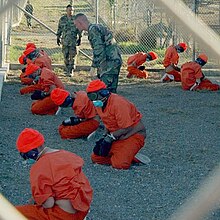
Michael R. Lehnert is a retired major general of the United States Marine Corps. He supervised the construction and served as the first commandant of the Guantanamo Bay Detention Camp.

Camp Delta is a permanent American detainment camp at Guantanamo Bay that replaced the temporary facilities of Camp X-Ray. Its first facilities were built between 27 February and mid-April 2002 by Navy Seabees, Marine Engineers, and workers from Halliburton subsidiary Kellogg, Brown and Root. It is composed of detention camps 1 through 6, Camp Platinum, Camp Iguana, the Guantanamo psychiatric ward, Camp Echo and Camp No. The prisoners, referred to as detainees, have uncertain rights due to their location not on American soil. There are allegations of torture and abuse of prisoners.
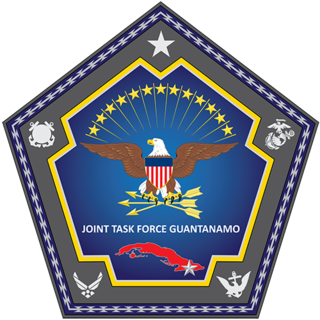
Joint Task Force Guantanamo (JTF-GTMO) is a U.S. military joint task force based at Guantanamo Bay Naval Base, Guantánamo Bay, Cuba on the southeastern end of the base. JTF-GTMO falls under US Southern Command. Since January 2002 the command has operated the Guantanamo Bay detention camps Camp X-Ray and its successors Camp Delta, Camp V, and Camp Echo, where detained prisoners are held who have been captured in the war in Afghanistan and elsewhere since the September 11, 2001 attacks. From the command's founding in 2002 to early 2022, the detainee population has been reduced from 779 to 37. As of June 2021, the unit is under the command of U.S. Army Brigadier General Lance A. Okamura.
Haji Faiz Mohammed is an elderly Afghani man who was held and interrogated by the United States military in the Guantanamo Bay detention camps, in Cuba. Mohammed spent about eight months in Guantanamo and was repatriated on October 28, 2002.
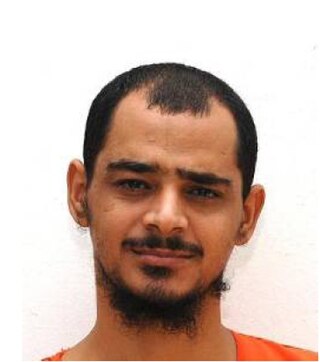
Adnan Farhan Abdul Latif, also known as Allal Ab Aljallil Abd al Rahman, was a Yemeni citizen imprisoned at the U.S. military prison at Guantanamo Bay, Cuba, from January 2002 until his death in custody there, ruled a suicide.
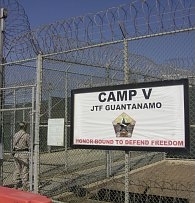
The Guantanamo Bay detention camp is a United States military prison within Guantanamo Bay Naval Base, also referred to as Gitmo, on the coast of Guantánamo Bay in Cuba. Of the 780 people detained there since January 2002 when the military prison first opened after the September 11 attacks, 741 have been transferred elsewhere, 30 remain there, and 9 have died while in custody.
Mohammed Saghir(also transliterated Mohammed Sanghir) is an elderly Pakistani who was held by the U.S. military in the United States Guantanamo Bay detention camps, in Cuba. His Guantanamo Internment Serial Number was 143. Joint Task Force Guantanamo counter-terrorism analysts estimate he was born in 1952, in Khohestan, Pakistan.
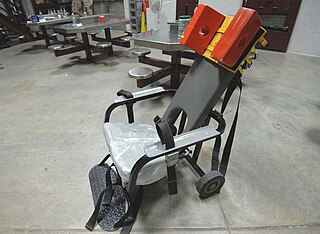
Mohammad Ahmed Abdullah Saleh Al Hanashi was a citizen of Yemen, held in extrajudicial detention in the United States Guantanamo Bay detainment camps, in Cuba. Al Hanashi's Guantanamo Internment Serial Number was 78. The Department of Defense reports that Al Hanashi was born in February 1978, in Abyan, Yemen.
Abd al-Salam al-Hilah is a citizen of Yemen, held in extrajudicial detention in the United States Guantanamo Bay detainment camps, in Cuba.
Ali Abdullah Ahmed, also known as Salah Ahmed al-Salami, was a citizen of Yemen who died whilst being held as an enemy combatant in the United States Guantanamo Bay detainment camps, in Cuba. His Guantanamo Internment Serial Number was 693. Joint Task Force Guantanamo counter-terror analysts estimated he was born in 1977, in Ibb, Yemen.

Sharqawi Abdu Ali al-Hajj, also known as Riyadh the Facilitator, is a Yemeni alleged Al-Qaeda associate who is currently being held in the United States' Guantanamo Bay detention camps, in Cuba.

The Wire is a weekly publication published by Joint Task Force Guantanamo, in Cuba—the unit responsible for the extrajudicial detention and interrogation of Guantanamo captives.

Jay W. Hood is a retired United States Army major general. His final assignment was as Chief Of Staff of the United States Central Command. His previous assignments include Commander of First Army Division East, Fort George G. Meade, Maryland; Commanding General of Joint Task Force Guantanamo (JTF-GTMO), Guantanamo Bay, Cuba; Assistant Division Commander (Forward), 24th Infantry Division and Deputy Commanding General (South), First Army, Fort Gillem, Georgia; Commander, 82nd Airborne Division Artillery and Commander, 3rd Battalion, 319th Field Artillery Regiment, 82nd Airborne, Fort Bragg, North Carolina; Commander, Battery D, 4th Battalion (Airborne), 325th Infantry, U.S. Army Southern European Task Force; and Commander, Battery A, 2nd Battalion, 321st Field Artillery Regiment, 82nd Airborne Division, Fort Bragg, North Carolina. General Hood is a graduate of Pittsburg (KS) State University
Paul Rester is the director of the Joint Intelligence Group at the United States' Guantanamo Bay detention camps, in Cuba—the Chief Interrogator.

The Least Worst Place: How Guantanamo Became the World's Most Notorious Prison is a 2009 book about the first several months of the operation of the Guantanamo Bay detention camps, in Cuba. The book's author, Karen J. Greenberg is Director of the Center on National Security at Fordham University's School of Law, and the author or co-author of several books on the George W. Bush Presidency's captive policies.

Detainees held in the United States' Guantanamo Bay detention camps have initiated both individual and widespread hunger strikes at Guantánamo Bay, and camp medical authorities have initiated force-feeding programs.
Guantanamo Bay homicide accusations were made regarding the deaths of three prisoners on June 10, 2006 at the United States Guantanamo Bay detention camp for enemy combatants at its naval base in Cuba. Two of the men had been cleared by the military for release. The United States Department of Defense (DOD) claimed their deaths at the time as suicides, although their families and the Saudi government argued against the findings, and numerous journalists have raised questions then and since. The DOD undertook an investigation by the Naval Criminal Investigative Service, published in redacted form in 2008.
Michael E. Dunlavey is a former major general in the United States Army. Following his retirement from the Army he was elected a State Judge in Erie Pennsylvania.

Mansur Ahmad Saad al-Dayfi is a citizen of Yemen who was wrongfully held without charge in the United States Guantanamo Bay detention camps in Cuba from February 9, 2002, to July 11, 2016. On July 11, 2016, he and a Tajikistani captive were transferred to Serbia. His Guantanamo Internment Serial Number is 441. JTF-GTMO analysts estimate he was born in 1979, in Sanaa, Yemen.



